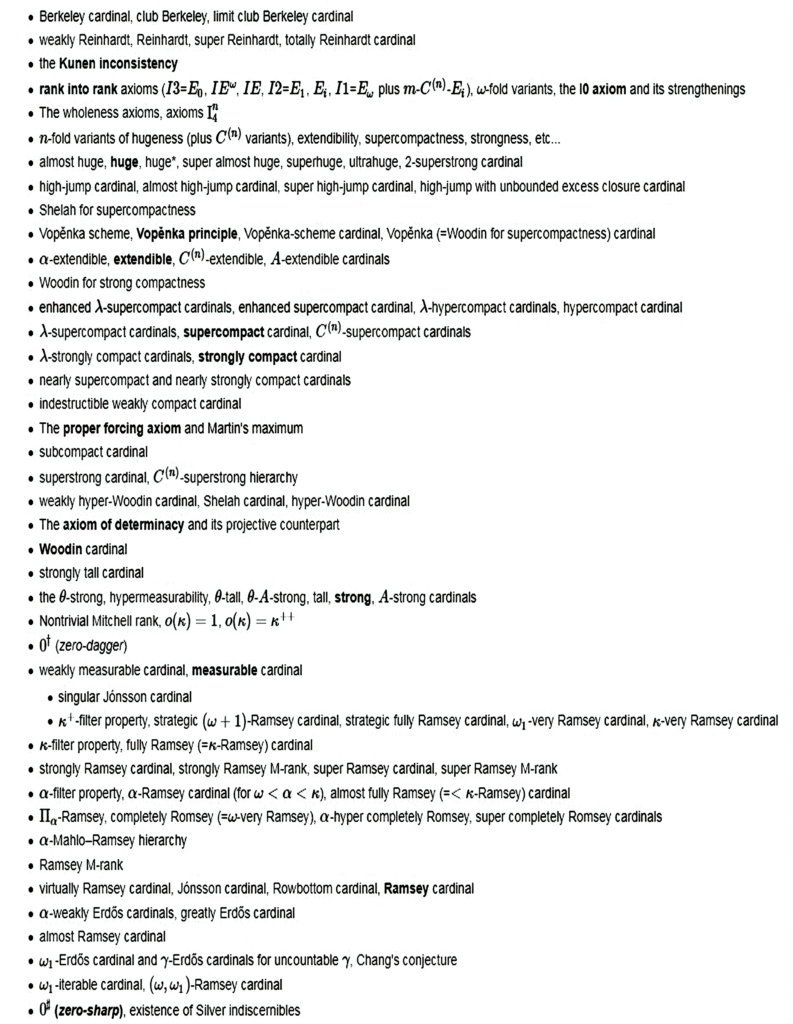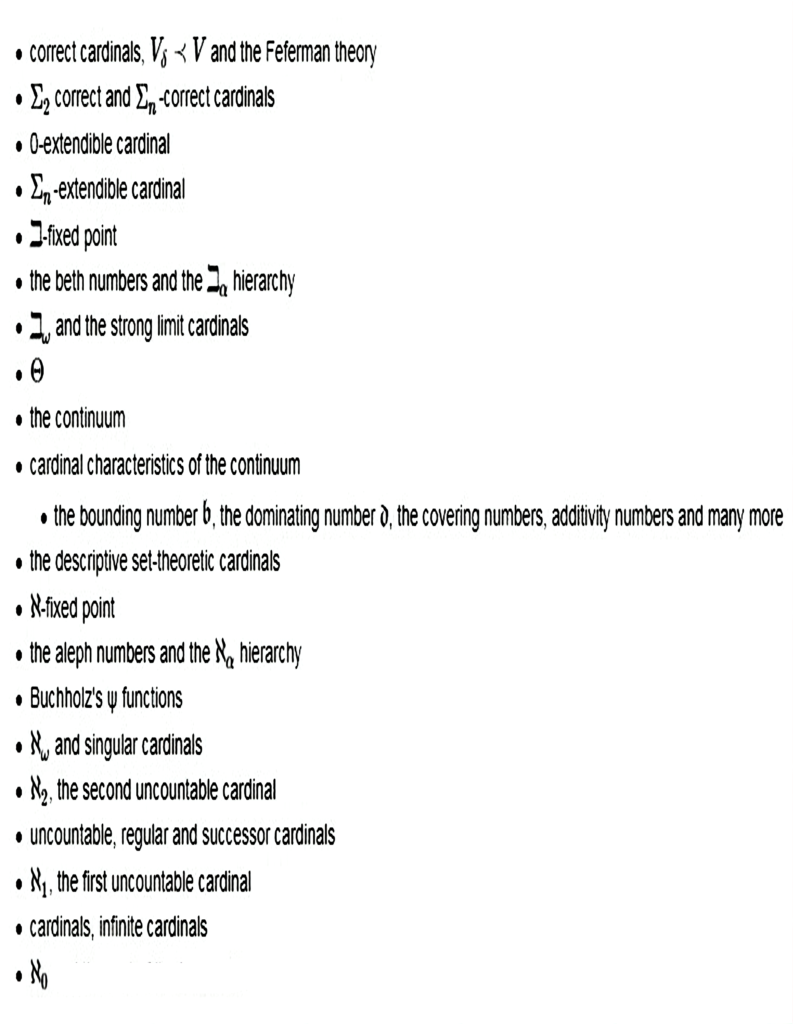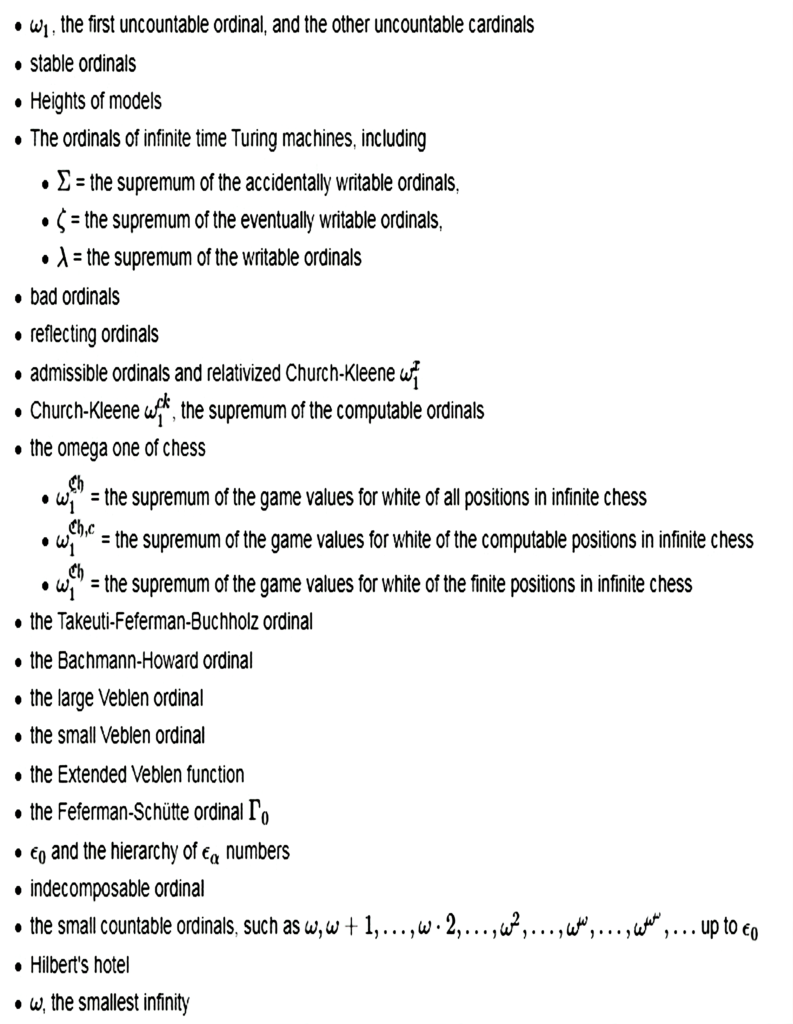The End of Infinity
This isn’t the actual name of this layer, but rather the expression of what it represents. It is the highest state of the grand principle of a transcendent infinity that transcends all inaccessible indeterminate transhierarchical systems and any expressions or modes of an absolutely infinite multiplicity. Any expression and perspective of infinity introduced before this stage are illusionary.
Upon reaching this realm, the Absolute Infinite, or rather, the notion that transcends and encompasses all infinities operates at its highest. Once reaching thing this stage, all elaborations, perspectives, and theories of absolute infinity are at their highest with each describable and indescribable level within it being governed by its own unique mathematical logic and metalogic. These levels are constantly growing and evermore complete, more expanded, logically greater, illogically greater, and increasingly abstract. Each level is an ever-expanding transhierarchical abstract comprehension of Master Sets—a completely greater transcendental level that includes, but exists beyond, all mathematically definable and indefinable concepts of infinity.
Upon reaching this realm, all sets are merely seen as a single “set of all sets.” Even the realm of infinite paradox arises here, considering the size of the set of all the infinite sizes of sets; which in effect, also operate at its highest transcendence.
All indeterminate inaccessible possible and impossible sets of infinite size (like the set of natural numbers), as well as the sets (like the set of real numbers) whose infinite sizes are larger, are at their highest. The conceptualization of infinite sequences of infinite sets whose infinite sizes are larger and larger infinities comes to its highest transcendence. This layer allows for uncountably indeterminate inaccessible infinite dimensions to even be.
Mathematically and Metamathematically, uncountably infinite cardinals beyond useful applications of all measures can be extended unto boundless scales, representing different complexities or qualitative “steps” on an inaccessible transconceptual boundless scale. The maximum nonvanishing Fictional, Nonfictional, Transfictional, Fanfictional, Metafictional, Patafictional, Interfictional, Personal Fictional, Impersonal Fictional, Incompatibilism Fictional, Impossible Fictional, Speculative Fictional, Xenofictional, Universal Genre, Universal Trope, Paratextual, Memetic Fictional, Transformation Fictional, and a priori and a posteriori Fictional expression of the following cardinals are realized here:
- "Small" cardinals: 0, 1, 2, ...,
,...,
, ... (so on...)
- worldly cardinals
- weakly and strongly inaccessible, α-inaccessible, and hyper inaccessible cardinals
- weakly and strongly Mahlo, α-Mahlo, and hyper Mahlo cardinals.
- reflecting cardinals
- weakly compact (= Π1
1-indescribable), Πm
n-indescribable, totally indescribable cardinals - λ-unfoldable, unfoldable cardinals, ν-indescribable cardinals, and λ-shrewd, shrewd cardinals
- ethereal cardinals, subtle cardinals
- almost ineffable, ineffable, n-ineffable, totally ineffable cardinals
- remarkable cardinals
- α-Erdős cardinals (for countable α), 0# (zero sharp), γ-iterable, γ-Erdős cardinals (for uncountable γ)
- almost Ramsey, Jónsson, Rowbottom, Ramsey, ineffably Ramsey, completely Ramsey, strongly Ramsey, super Ramsey cardinals
- measurable cardinals, 0†(zero dagger)
- λ-strong, strong cardinals, tall cardinals
- Woodin, weakly hyper-Woodin, Shelah, hyper-Woodin cardinals
- superstrong cardinals
- subcompact, strongly compact, supercompact, hypercompact cardinals
- η-extendible, extendible cardinals
- Vopěnka cardinals, Shelah for supercompactness, high jump cardinals
- n-superstrong (n≥2), n-almost huge, n-super almost huge, n-huge, n-superhuge cardinals
- Wholeness axiom, rank-into-rank (Axioms I3, I2, I1, and I0)
- HODHOD-Super Reinhardt cardinals, HODHOD-Reinhardt cardinals
- Reinhardt cardinal, Super Reinhardt cardinals
- Berkeley cardinal, hyper-Berkeley cardinal
Step into the upper realm of the End of Inifnity, where the ethereal domain of large cardinals resides, transcending the bounds of ordinary infinity. Here, we ascend beyond the realm of the inaccessible and ineffable, delving into the realm of intricate and infinitely expandable concepts, only to confront the looming specter of inconsistency.
The following is listed from highest to lowest:


Step into the middle End of Infinity, the realm where uncountable cardinals, the stalwart pillars of mathematics, commence their perpetual ascent in structure. Here, we explore the realm of infinite cardinals, whose existence aligns with or is equiconsistent with the ZFC axioms of set theory.
The following is listed from highest to lowest:

Welcome to the lower End of Infinity, where countably infinite ordinals ascend perpetually, stacking one upon another in an eternal, self-referential climb.
The following is listed from highest to lowest:

In the branch of mathematical logic that links to sets, large cardinals are certain kinds of infinite cardinal numbers that possess special properties beyond the familiar concept of counting. They play a crucial role in understanding the hierarchy of sets and the consistency of different set-theoretical axioms. Inaccessible indeterminate large cardinals are a specific class of large cardinals that exhibit both inaccessibility and indeterminacy.
- Cardinal Numbers and Infinity: In mathematics, cardinal numbers are used to describe the sizes of sets. For finite sets, cardinality corresponds to the number of elements in the set (e.g., the cardinality of {1, 2, 3} is 3). However, when dealing with infinite sets, the concept of cardinality becomes more nuanced.
- Ordinals and Cardinals: Ordinal numbers extend the concept of counting to describe the order or arrangement of elements in a well-ordered set. Each ordinal corresponds to a unique order type. Cardinals are a subset of ordinals that describe the size of sets without considering their order.
- Inaccessible Cardinals: An inaccessible cardinal is a large cardinal number that cannot be reached by any standard operations of set theory, such as power sets or unions, starting from smaller cardinal numbers. In other words, an inaccessible cardinal is a cardinal that cannot be generated within the hierarchy of sets using the usual operations.
- Indeterminate Cardinals: An indeterminate cardinal is a large cardinal number that is not determined by the axioms of set theory alone. This means that its existence is consistent with various set-theoretical axioms, but these axioms alone do not fully establish the existence or nonexistence of such a cardinal.
- Inaccessible Indeterminate Cardinals: Combining the concepts of inaccessibility and indeterminacy, we arrive at inaccessible indeterminate large cardinals. These are large cardinal numbers that are both unreachable by standard set-theoretical operations and not definitively determined by existing axioms. Their existence is consistent with set theory, but proving or disproving their existence requires extending the axiomatic framework.
- Role in Set Theory: Large cardinals, including inaccessible indeterminate ones, have profound implications for set theory. They help establish the consistency of different set-theoretical axioms and provide insights into the hierarchy of sets and the nature of infinity. The study of large cardinals often involves exploring their relationships to other large cardinals, their implications for the structure of the universe of sets, and their connections to other branches of mathematics.
In summary, inaccessible indeterminate large cardinals are a fascinating aspect of set theory that combines the concepts of inaccessibility and indeterminacy. These cardinals are unreachable by standard operations and not fully determined by existing axioms.
The End of Infinity contains layers such as:
Infinity and Beyond: In mathematics, infinity is not treated as a singular concept but as a hierarchy of different infinities, each represented by a cardinal number. The smallest infinity is represented by ℵ₀ (aleph-null), the cardinality of the set of natural numbers. Larger infinities correspond to larger cardinal numbers, denoted by ℵ₁, ℵ₂, and so on.
The Role of Large Cardinals: Large cardinal numbers extend the concept of infinity by introducing even larger infinities that possess specific properties. Large cardinals are cardinal numbers that satisfy certain conditions that make them "large" relative to the standard hierarchy of cardinal numbers.
Hierarchy of Large Cardinals: Large cardinals form a hierarchy, much like the hierarchy of infinity. Starting from measurable cardinals, which are the smallest large cardinals, the hierarchy continues with various levels such as strongly inaccessible, weakly compact, indescribable, and more. Each level of large cardinality adds new properties that distinguish them from smaller cardinals.
Consistency and Independence: The existence of large cardinal numbers, especially those at higher levels of the hierarchy, raises questions about their consistency with standard set-theoretical axioms (like ZFC, Zermelo-Fraenkel set theory with the Axiom of Choice). Some large cardinals, such as inaccessible cardinals, are consistent with ZFC, while others, like supercompact cardinals, require additional set-theoretical assumptions.
Universes of Sets: The concept of a "universe of sets" refers to a mathematical structure that models a consistent set-theoretical universe. Large cardinals play a role in constructing these universes. The concept of V (the von Neumann universe) and related models like L (the constructible universe) are explored to understand the interplay between large cardinals and the structure of sets.
Large Cardinals and Independence Proofs: Large cardinal axioms have been used to prove the consistency of other mathematical statements or axioms. For example, Gödel's constructible universe L was shown to be equiconsistent with the existence of measurable cardinals. These results provide insight into the inherent complexity of mathematical systems.
Reaching, exiting, or stepping beyond this layer is a solid conclusion that one has surpassed all sets, proper classes, and imaginary realms that are nonvanishing absolutely infinite in size (their size can nonetheless be increased). Reaching, exiting, or stepping beyond this layer means that one has surpassed the totality of completion, and surpassed the fully transcendent infinitely-layered hierarchies and/or beyond dimensional levels on a transconceptual and existential level. Ultimately, in itself, this layer is not characterized by any particular property and is thus ineffable and conceptually unsolvable. Those lower than this layer can only acknowledge and admit to it, but never know or approximate it.
The End of Infinity is transcendentally boundless in its own way. It not only transcends the fictionalized version of our real world, but it also ascends beyond the author. The End of Infinity ascends an absolute infinite multiplicity amount of steps above the author, so much that each step possesses the transhierarchical expanse of large cardinals. The End of Infinity is the possibility and actuality of constantly "absolutely transcending Be-All, End-All or beyond Be-All, End-All", including itself. The defining quality of the End of Infinity is that it is more Be-All, End-All than endless Fictional, Nonfictional, Transfictional, Fanfictional, Metafictional, Patafictional, Interfictional, Personal Fictional, Impersonal Fictional, Incompatibilism Fictional, Impossible Fictional, Speculative Fictional, Xenofictional, Universal Genre, Universal Trope, Paratextual, Memetic Fictional, Transformation Fictional, and a priori and a posteriori Fictional possibilities, impossibilities, and existences. It is always "more" conceptually higher than what "it", "is", "you", "be-all, "end-all", "beyond-all", and "beyond the beyond" are.

Within this realm also exists Plato’s Cave.
Plato’s Cave is the accumulation of the boundless extensions and intensions of the boundless forms of knowledge, reality, and the nature of (be-ness, sameness, oneness, and cosmic otherness) existence.
Plato's Cave describes a group of prisoners who have been confined inside a dark cave since birth. They are bound in such a way that they can only see the wall in front of them, unable to turn their heads. Behind them, there is a fire, and between the fire and the prisoners, there is a raised walkway.
As objects pass along the walkway, they cast shadows on the wall in front of the prisoners. These shadows are the only things the prisoners can perceive, and since they have never seen anything else, they believe these shadows to be the only reality. The echoes of the objects and the voices of the people moving along the walkway are also heard by the prisoners, further shaping their understanding of the world.
Plato suggests that one of the prisoners is freed and forced to turn around and look towards the fire and the objects creating the shadows. Initially, the freed prisoner is dazzled by the light and finds it difficult to comprehend the objects as the true source of the shadows. Gradually, the prisoner's eyes adjust, and they begin to understand that the shadows were mere illusions and that the objects themselves are the true reality.
However, Plato doesn't stop there. He posits that if the freed prisoner were to be taken out of the cave and exposed to the outside world, they would experience even greater confusion and awe. The sunlight would be blinding at first, but as their eyes adjust, they would see the actual objects in their true form and realize that the cave was just a dim, distorted representation of reality.
The Cave serves as a house for Plato's Forms or Ideas. According to Plato, the physical world we perceive through our senses is just a mere reflection or shadow of the true reality, which exists in the realm of Forms. The objects in the cave represent the physical world, while the shadows they cast symbolize the illusions and appearances we encounter in our everyday lives. The journey of the freed prisoner represents the philosopher's pursuit of knowledge and the discovery of the higher truths and eternal Forms that lie beyond the sensory realm.
In summary, the Cave encompasses the distinction between the perceived world of appearances and the true reality that lies beyond our immediate senses. It is the definitive answer to perceptions, knowledge, and a deeper understanding of the world around them.
The End of Infinity contains Realism, which is a significant philosophical position within metaphysics that deals with the nature of reality and the existence of entities beyond our immediate perception. Realism asserts that there are objective, mind-independent entities that exist regardless of whether they are being observed or thought about. This perspective has far-reaching implications for our understanding of the world, knowledge, and the relationship between our thoughts and the external world. Here's a detailed explanation of realism:
- Ontological Realism: Ontological realism, often simply referred to as realism, is the view that there are objective entities, properties, and relations that exist independently of human thought, perception, or language. These entities are not contingent upon our awareness of them; they exist whether or not we are aware of their existence.
- Existence of Universals: One of the central concerns of realism is the existence of universals. Universals are abstract qualities, properties, or attributes that can be instantiated by multiple individuals or particulars. For example, the quality of "redness" is a universal that can be instantiated in various red objects.
- Platonic Realism: Plato's theory of Forms is a famous example of realism. Plato argued that there is a realm of non-physical, eternal Forms or Ideas that exist independently of the physical world. These Forms are perfect, unchanging entities that serve as the ultimate reality behind the imperfect physical world.
- Aristotelian Realism: Aristotle's approach to realism is more moderate. He believed that universals do exist, but they exist within individual particulars. In other words, the universal "redness" is instantiated in every individual red object, and the particulars possess the qualities.
- Scientific Realism: In the realm of science, scientific realism asserts that the entities and mechanisms posited by scientific theories are real and exist independently of our observations or interpretations. It holds that scientific theories aim to describe an objective reality, even if our understanding of that reality is incomplete.
- Structural Realism: Structural realism is a modern version of realism that focuses on the underlying structures of reality rather than specific entities. It argues that while our understanding of individual entities may change, the fundamental relationships and structures that govern reality remain constant.
- Epistemic Realism: Epistemic realism concerns the status of our knowledge. Epistemic realists hold that our beliefs and knowledge can correspond to an objective reality. In other words, our beliefs can accurately represent the way the world actually is.
- External World Realism: A specific aspect of realism is external world realism, which asserts that the physical world we perceive and interact with exists independently of our perception. This view stands in contrast to skepticism, which raises doubts about the existence of an external reality.
Universals are a philosophical concept within the End of Infinity that deals with the nature of abstract properties, qualities, or entities that are shared by multiple individuals or particulars. Universals are often contrasted with particulars, which are individual instances or objects. Here's a detailed explanation of universals in the End of Infinity:
- Basic Distinction: At the heart of universals is the distinction between the universal and the particular. Universals are abstract entities or concepts that can be instantiated in multiple instances, while particulars are concrete, individual instances of those universals.
- Examples of Universals: Universals are often associated with qualities, properties, or attributes that multiple things can share. For example, the universal "redness" can be instantiated in various red objects like roses, apples, and fire trucks. Other examples of universals include "humanity," "roundness," "beauty," and "justice."
- Realism vs. Nominalism: The debate about universals centers around questions of their ontological status. Realism holds that universals have an independent existence, regardless of whether they are instantiated in particulars. Nominalism, on the other hand, argues that universals are mere names or labels for collections of similar particulars without any independent reality.
- Plato's Theory of Forms: One of the earliest and most influential theories of universals comes from Plato's theory of Forms. According to Plato, universals exist in a separate realm of reality, the world of Forms. The physical world is a shadowy reflection of these perfect, eternal Forms.
- Aristotle's Concept of Universals: Aristotle, a student of Plato, proposed an alternative view. He believed that universals do not exist as separate entities but are inherent in the particulars themselves. According to Aristotle, universals are "instantiated" in particulars, and the particulars are what possess the qualities.
- Medieval Debates: The debate over universals continued during the medieval period. Realist philosophers like Thomas Aquinas argued for the existence of objective universals, while nominalists like William of Ockham held that universals were simply linguistic conveniences.
- Problem of Universals: The problem of universals is the philosophical question of how to account for the relationship between universals and particulars. This problem raises issues about the nature of reality, perception, language, and knowledge.
- Contemporary Views: In contemporary philosophy, the debate over universals continues with various nuanced positions. Some philosophers propose a moderate realism, suggesting that universals exist but are not separate from particulars. Others explore conceptualism, which views universals as mental constructs, or trope theory, which posits that properties are individual instances.
- Implications for Language and Knowledge: The debate over universals has implications for our understanding of language and how we communicate about shared qualities or attributes. It also touches on the nature of concepts and how we acquire knowledge about the world.
- Metaphysical Significance: The debate over universals is not just an abstract exercise; it has deep metaphysical implications for our understanding of the nature of reality, the relationship between abstract concepts and the physical world, and the limits of human understanding.
The End of Infinity contains the unified concept of universals that involves the exploration of abstract qualities or attributes that can be shared among multiple individuals or particulars.
